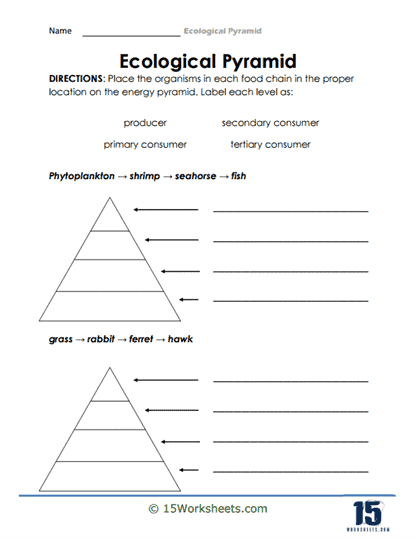Food Chains

Worksheet Description
Place the organisms in each food chain in the proper location on the energy pyramid. Label each level as either:
- producer
- secondary consumer
- primary consumer
- tertiary consumer
The worksheet will aid students in comprehending the structure of energy pyramids and the flow of energy through various trophic levels within an ecosystem. Students are presented with two distinct food chains, one aquatic and the other terrestrial. Their task is to correctly place and label each organism within the respective energy pyramid according to its role as a producer, primary consumer, secondary consumer, or tertiary consumer. The empty pyramids alongside the food chains serve as a visual guide for students to illustrate the decreasing amount of energy available as one moves up the trophic levels.
To execute this task effectively, students should first identify the base of each food chain, which represents the producers. In the given chains, phytoplankton and grass serve as the primary energy sources. Following the flow of energy, the subsequent organism in the chain becomes the primary consumer, the next as the secondary consumer, and so on. By visually plotting each organism in the pyramid, students can see the energy hierarchy and understand the decreasing energy availability as they progress to higher trophic levels.
The worksheet aims to foster a clear understanding of the concept of energy pyramids and the flow of energy within ecosystems. By actively labeling and placing each organism in the pyramid, students engage with the material, reinforcing the idea of energy dissipation as it moves through trophic levels. This hands-on approach allows learners to visualize the energy distribution and emphasizes the significance of producers as the foundational energy source in any ecosystem. Ultimately, the worksheet endeavors to cultivate an appreciation for the intricate relationships and energy dynamics present in the natural world.
